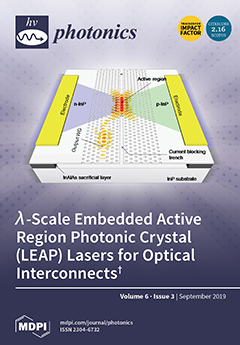We report non-invasive, bilateral optical measurements on the forehead of five healthy human subjects, of 0.1 Hz oscillatory hemodynamics elicited either by cyclic inflation of pneumatic thigh cuffs, or by paced breathing. Optical intensity and the phase of photon-density waves were collected with
[...] Read more.
We report non-invasive, bilateral optical measurements on the forehead of five healthy human subjects, of 0.1 Hz oscillatory hemodynamics elicited either by cyclic inflation of pneumatic thigh cuffs, or by paced breathing. Optical intensity and the phase of photon-density waves were collected with frequency-domain near-infrared spectroscopy at seven source-detector distances (11–40 mm). Coherent hemodynamic oscillations are represented by phasors of oxyhemoglobin (
O) and deoxyhemoglobin (
D) concentrations, and by the vector
D/
O that represents the amplitude ratio and phase difference of
D and
O. We found that, on an average, the amplitude ratio (|
D/
O|) and the phase difference (∠(
D/
O)) obtained with single-distance intensity at 11–40 mm increase from 0.1° and −330° to 0.2° and −200°, respectively. Single-distance phase and the intensity slope featured a weaker dependence on source-detector separation, and yielded |
D/
O| and ∠(
D/
O) values of about 0.5 and −200°, respectively, at distances greater than 20 mm. The key findings are: (1) Single-distance phase and intensity slope are sensitive to deeper tissue compared to single-distance intensity; (2) deeper tissue hemodynamic oscillations, which more closely represent the brain, feature
D and
O phasors that are consistent with a greater relative flow-to-volume contributions in brain tissue compared to extracerebral, superficial tissue.
Full article





